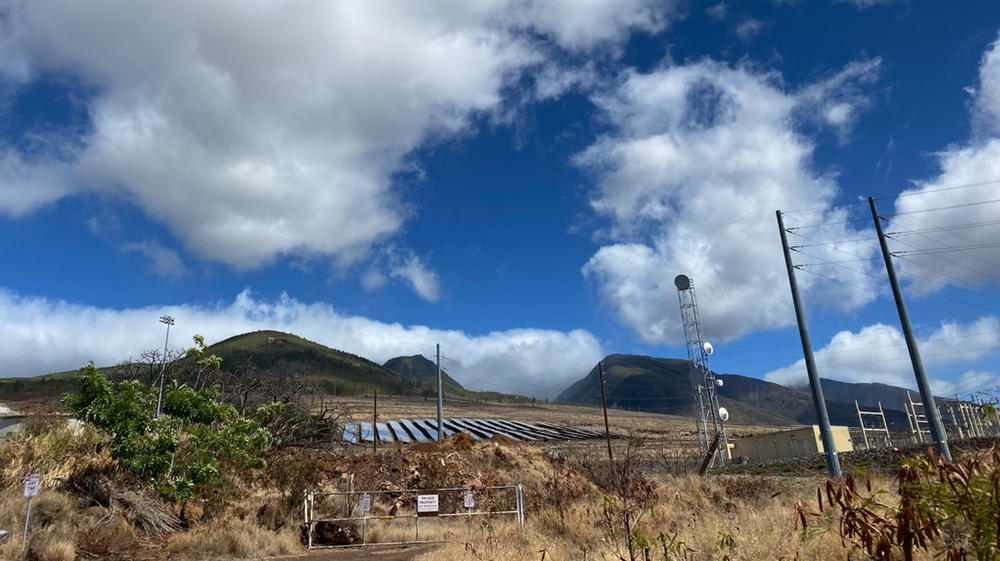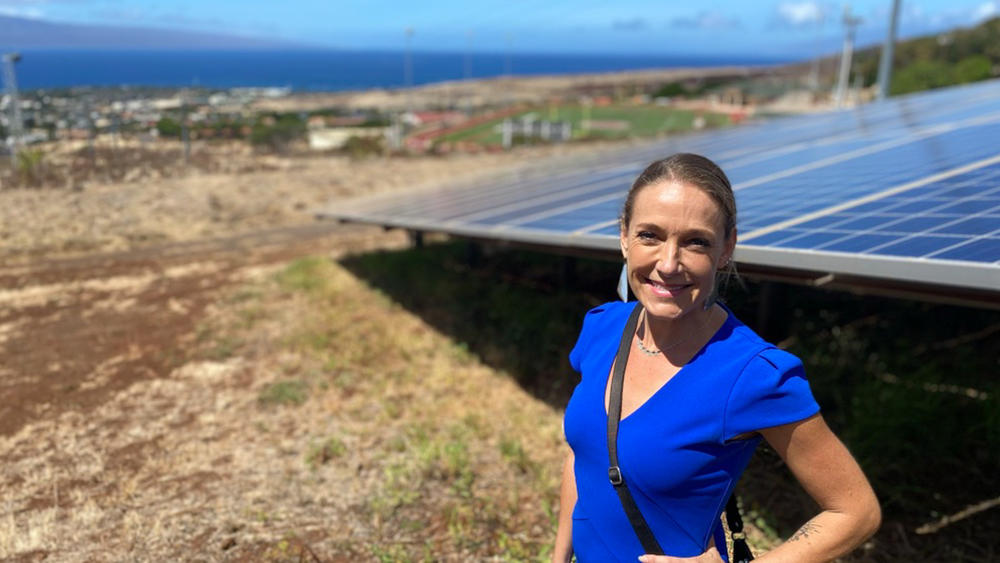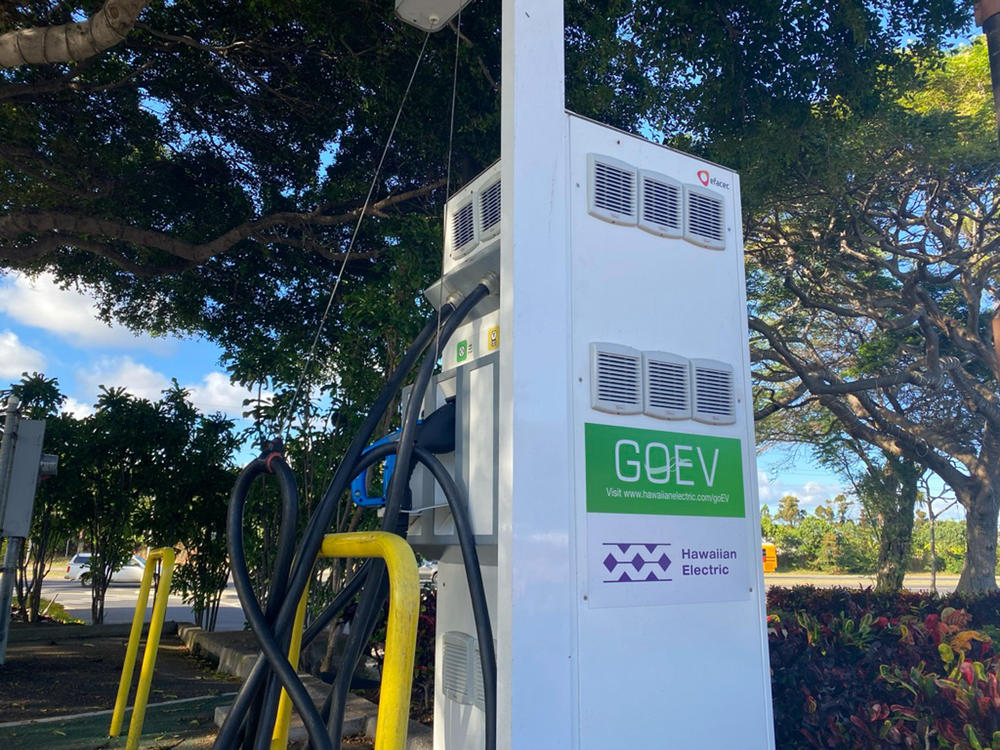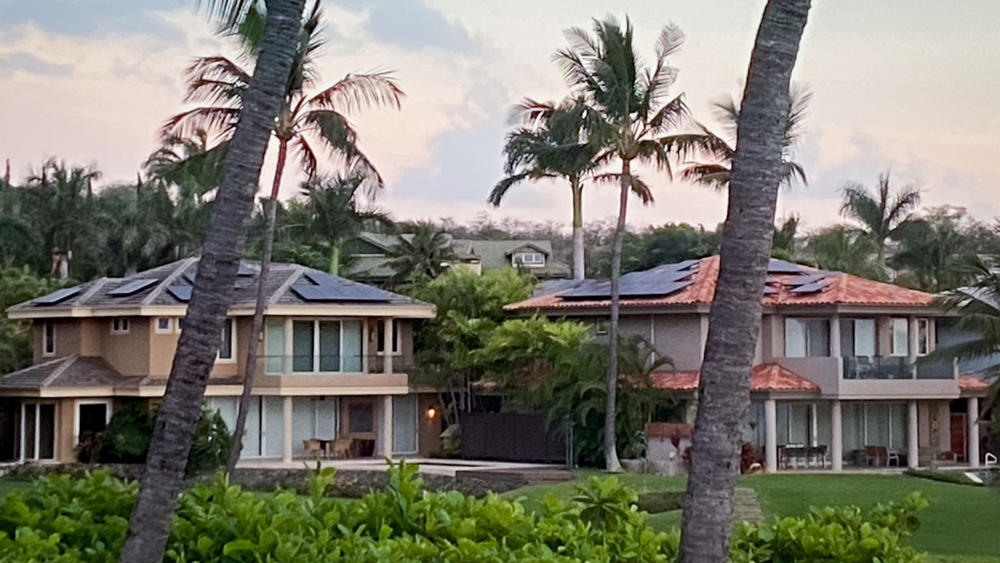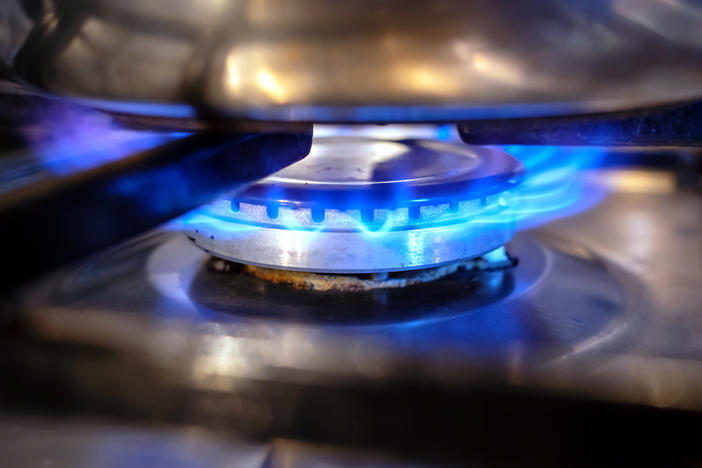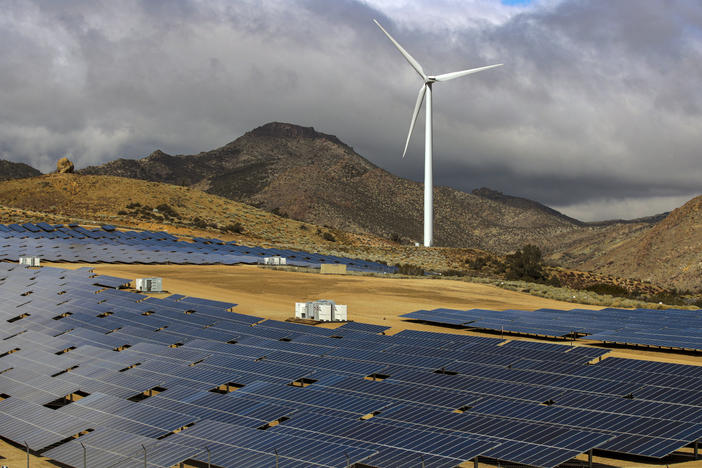Section Branding
Header Content
Biden's climate agenda is stalled in Congress. In Hawaii, one key part is going ahead
Primary Content
On the island of Maui, up a dirt road past some very productive mango trees, there's a solar plant with a view of the Pacific.
Under the solar panels, Hawaii Public Utility Commissioner Jennifer Potter is sitting on the shady hill. It's several degrees cooler out of the sun, "I think fifteen degrees or so," Potter says.
A solar company built this plant, not the monopoly electric utility Potter regulates, and for Potter, that's a good thing. For the green transition to work, she says, it can't just be the monopoly utility making renewable energy – lots of renewable energy producers will need to be on the grid.
The problem, she argues, is that traditionally, the monopoly utility, Hawaiian Electric, hasn't had a clear incentive to hook up renewable energy from projects like this quickly.
"This project was ten years coming from start to finish," Potter says, "Ten years! That's problematic. We see that as being a huge issue."
Sixty percent of US electricity still comes from fossil fuels and while the country is moving toward cleaner energy, it's doing so slowly. Potter thinks part of that comes back to utility regulators like her.
That's why Potter and her colleagues in Oahu have embarked on an experiment to retool more than a hundred years of regulatory precedent and get Hawaii's power company off fossil fuels. The state has begun implementing a system of incentives – and some penalties– to speed up the transition to 100% renewable energy.
This carrot-and-stick approach to getting utilities off fossil fuels is reminiscent of a central climate plan that Biden and Congressional Democrats pushed for in the Build Back Better bill. Senator Joe Manchin successfully fought to remove the program from the bill in October, before rejecting the whole bill outright two months later.
But Hawaii's comprehensive utility reform could be a transformative tool, and other states are looking at it, too. Cara Goldenberg is a manager on the carbon-free electricity team at RMI and she worked as a consultant for Hawaii's reforms. She says the failure of the climate change bill raises the stakes for states like Hawaii to take the lead on decarbonizing electricity.
"Policy makers can set pretty ambitious goals, 'we're going to be net zero' or however they want to frame it. But the crux of it all is, 'OK, but how are utilities actually going to be able to achieve these goals?'" she says. "With no federal legislation in sight, I think it becomes even more important for states to develop the policies and regulations that are required to incentivize utilities to decarbonize."
How utilities are regulated has changed little in a century
To understand how Hawaii is changing the game, it helps to go back to the 1890s, when a bunch of electric companies were competing to power America.
"If you look back at some of the old sepia-toned pictures of cities from those days, there was like a crow's nest of wires on every street corner," says utility regulatory consultant Karl Rábago. "It looked like heck and it was probably pretty unsafe."
In this era, utility companies made the case for getting monopoly status. "There was an argument that you could provide electricity more efficiently if only one company did it," says Rábago.
State-level regulators would govern how the monopoly utility made profits, and the profit formula that won the day was one that incentivizes utilities to build infrastructure quickly, says Hannah Polikov, managing director of Advanced Energy Economy, a trade group for clean energy groups. "The way it's set up is the more that utilities build, the more money that they make," Polikov says.
At the time, when America needed lots of new power plants and transmission lines, Polikov says this incentive structure made a lot of sense: "Historically, when the goal was to go from zero electrification to universal electrification--right?--we had to deploy a whole lot of assets to get everyone electricity."
But today, amidst pledges to get the electricity sector off fossil fuels, Hawaii's regulators say this old formula is out of place. Instead of encouraging utilities to "build, build, build", Potter says regulators like herself need to incentivize new things, like energy efficiency, and connecting renewable energy to the grid – often from projects the monopoly utility hasn't built itself.
The federal Energy Information Administration estimates that 77% of Hawaii's power comes from burning fossil fuels, mostly oil and some coal. With a state deadline of getting the utility to 100% renewables by 2045, Hawaii will need to shut down oil and coal plants early. Utility commissioner Leo Asuncion says the old profit formula typical for the industry would have motivated Hawaii's monopoly utility to do the opposite. "They want to keep their plants operating as much as possible," he says, "Because it's in their best interests in that formula."
New reforms mean carrots and sticks
On June 1, Hawaii officially kicked off new reforms called "performance-based regulation." In 2018, when the regulators decided to do a top-to-bottom overhaul of the regulatory structure, there were worries about the financial impact on the utility, Hawaiian Electric, says James Griffin, Chair of Hawaii's Public Utility Commission.
At the time, the utility was "one step above junk bond status," Griffin says. "There were a lot of clouds of uncertainty over how this process would roll out. Is our utility going to be viewed as higher risk or lower risk versus their competitors?"
But Griffin says he got more confidence when he heard Toby Shea, a Vice President at Moody's, give a presentation to the commission arguing that the traditional regulatory model takes utilities down the wrong path.
Shea says that the old model doesn't incentivize the utility to keep down costs – which will become a big problem for utilities with climate change. "The renewable transition and environmental related challenges will cost money," he says, "And one of the things that will be needed is to reduce costs so that customers' bills don't get out of control."
That's where performance-based regulation comes in. What Hawaii is doing, says Griffin, is setting up a new regulatory framework that incentivizes the utility to both cut costs and achieve climate friendly goals.
For Griffin, a key step was putting the utility on a five-year budget. "It's a very powerful incentive for cost savings, and we're seeing it take effect," he says. That's because the utility is given a set amount of money for five years, "and if they can drive their costs below that, they actually get to keep [part of] that as profit for now."
The five-year budget became a target window for the utility to achieve new climate change related goals. Following models from the United Kingdom and Alberta, Canada, the regulators gathered community stakeholders together in brainstorming workshops to figure out what those goals would be.
They agreed on things like bringing more renewables on the grid and pilot projects for electric vehicle infrastructure. They also agreed to reduce customer bills. Because of its reliance on imported oil, Hawaii has the highest average electric rates in the US.
Now, if the utility reaches the goals, they receive additional incentive payments, and if they don't they sometimes get penalties, or as Jim Kelly, Vice President for Hawaii Electric says, "Carrots and sticks! Carrots and sticks!"
One incentive program revolves around getting solar hooked up to the grid more quickly. While Kelly argues the utility was trying to get renewables online long before these reforms, he says Hawaiian Electric now has a specific profit motive to connect rooftop solar faster.
"If we can continue to make that interconnection experience a positive thing, then it's potentially up to three million dollars upside for us," Kelly says. If the utility fails to meet solar interconnection goals across the islands, it could face up to $900,000 in yearly fines.
Kelly says so far, Hawaiian Electric is meeting the solar hook up targets. He says a year ago it would take an Oahu customer seven weeks on average to set up their rooftop solar, and now it's taking about half that time.
As for the larger goal of increasing the state's renewable energy portfolio, Hawaiian Electric says that if they continue to bring projects online they could get as much as a $15 million bonus by 2023.
Toby Shea of Moody's says investors generally prefer performance-based models because they often produce better earnings and cash flows for companies. Even before the official launch of performance-based regulation S&P and Moody's upgraded their rating for Hawaiian Electric. Fitch upgraded their rating just after the launch.
And as for the costs to consumers, Hawaiian Electric's customers are now receiving a yearly dividend to keep their bills down.
Other states are exploring this kind of utility reform
While some states like New York, Rhode Island, Minnesota, and Massachusetts have implemented elements of performance-based regulation, now more states are looking to comprehensive restructuring like Hawaii, including Washington, Illinois, North Carolina and Connecticut.
Marissa Gillett is the Chair of Connecticut's Public Utilities Regulatory Authority and she says her regulatory commission is looking to Hawaii's model specifically, "the only state that has really tried to take it from soup to nuts."
Gillett says it will be helpful to point to Hawaii if she hears concerns from Connecticut's monopoly utility. "I am sensitive to the fact that this is an industry that's existed for centuries at this point and moving them in a different direction you have to overcome a lot of inertia."
Ultimately, Kelly of Hawaiian Electric argues that other utilities around the US should recognize that performance-based regulation is coming. "If you think that you can put it off, maybe you can for a few years, but it's probably going to happen in some form or another."
Julia Simon is a regular contributor to NPR's podcasts and news desks, focusing on climate change, energy and business news.
Copyright 2022 NPR. To see more, visit https://www.npr.org.
Bottom Content

